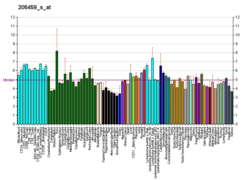| WNT2B |
|---|
|
| Identifiers |
|---|
| Aliases | WNT2B, WNT13, Wnt family member 2B |
|---|
| External IDs | OMIM: 601968; MGI: 1261834; HomoloGene: 22526; GeneCards: WNT2B; OMA:WNT2B - orthologs |
|---|
| Gene location (Human) |
|---|
 | | Chr. | Chromosome 1 (human)[1] |
|---|
| | Band | 1p13.2 | Start | 112,466,541 bp[1] |
|---|
| End | 112,530,165 bp[1] |
|---|
|
| Gene location (Mouse) |
|---|
 | | Chr. | Chromosome 3 (mouse)[2] |
|---|
| | Band | 3 F2.2|3 45.88 cM | Start | 104,852,588 bp[2] |
|---|
| End | 104,869,237 bp[2] |
|---|
|
| RNA expression pattern |
|---|
| Bgee | | Human | Mouse (ortholog) |
|---|
| Top expressed in | - germinal epithelium
- buccal mucosa cell
- parietal pleura
- gonad
- skin of hip
- optic nerve
- skin of thigh
- epithelium of colon
- right ovary
- left ovary
|
| | Top expressed in | - epithelium of female urethra
- muscle layer of urethra
- pretectal area
- muscle layer of ejaculatory duct
- lamina propria of urethra
- vagina
- anterior lobe of prostate
- lamina propria of vagina
- pelvic part of vagina
- muscle layer of seminal vesicle
|
| | More reference expression data |
|
|---|
| BioGPS | 
 | | More reference expression data |
|
|---|
|
| Gene ontology |
|---|
| Molecular function | - frizzled binding
- signaling receptor binding
| | Cellular component | - extracellular region
- extracellular space
- intracellular membrane-bounded organelle
- collagen-containing extracellular matrix
| | Biological process | - cell fate commitment
- positive regulation of branching involved in ureteric bud morphogenesis
- male gonad development
- chondrocyte differentiation
- positive regulation of canonical Wnt signaling pathway
- iris morphogenesis
- cornea development in camera-type eye
- cellular response to starvation
- hematopoietic stem cell proliferation
- lung induction
- multicellular organism development
- forebrain regionalization
- lens development in camera-type eye
- neuron differentiation
- mesenchymal-epithelial cell signaling
- canonical Wnt signaling pathway
- Wnt signaling pathway
| | Sources:Amigo / QuickGO |
|
| Orthologs |
|---|
| Species | Human | Mouse |
|---|
| Entrez | | |
|---|
| Ensembl | | |
|---|
| UniProt | | |
|---|
| RefSeq (mRNA) | |
|---|
NM_024494
NM_001291880
NM_004185 |
| |
|---|
| RefSeq (protein) | |
|---|
NP_001278809
NP_004176
NP_078613 |
| |
|---|
| Location (UCSC) | Chr 1: 112.47 – 112.53 Mb | Chr 3: 104.85 – 104.87 Mb |
|---|
| PubMed search | [3] | [4] |
|---|
|
| Wikidata |
| View/Edit Human | View/Edit Mouse |
|



















